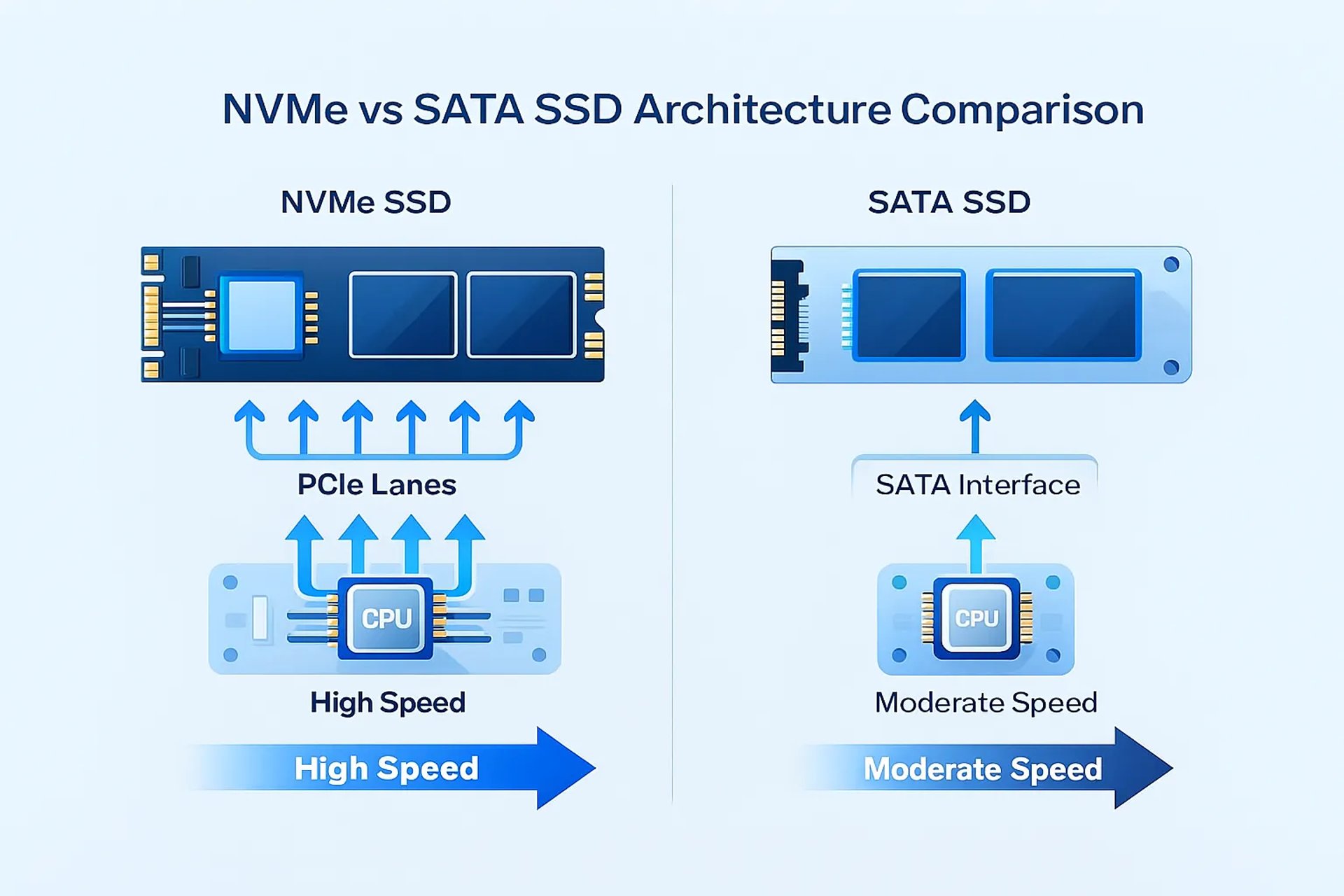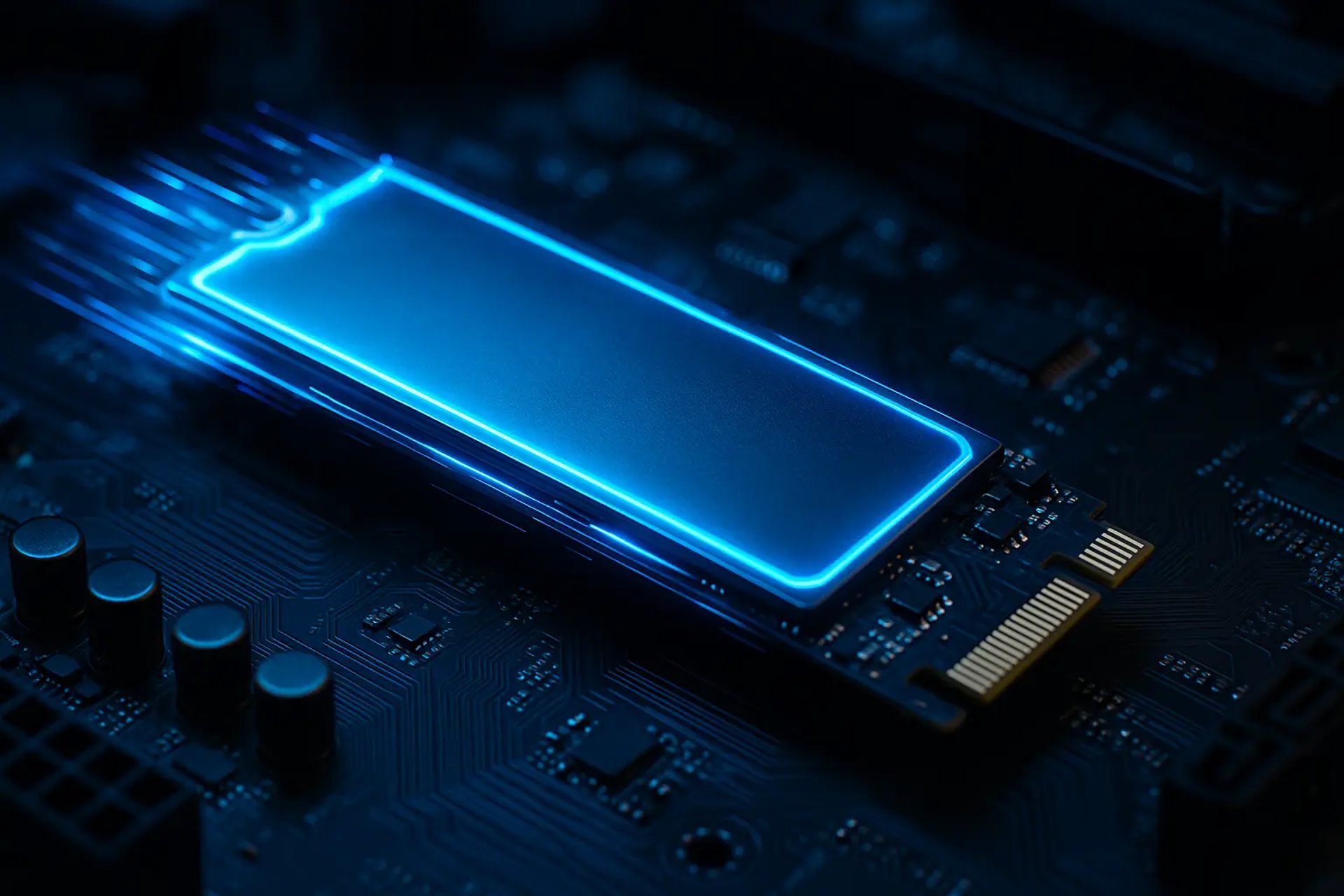NVMe SSD Explained: Why It’s Faster Than HDDs & SATA SSDs
Learn how NVMe SSD work, why they’re faster than HDDs and SATA SSDs and how PCIe lanes boost speed, performance and reliability in modern computers.
🖥️ COMPUTERS & ELECTRONICS
If you've ever wondered why your new computer boots up in seconds while an older model takes half a minute the answer likely lies in your storage drive. The jump from traditional hard disk drives to solid-state drives was already revolutionary but NVMe technology has pushed performance boundaries even further. Understanding how NVMe SSDs work reveals why they've become the gold standard for modern computing performance.
The Foundation: Understanding Storage Evolution
To appreciate NVMe's innovations, we need to understand the journey that led here. Hard disk drives have dominated storage for decades, using spinning magnetic platters and moving read/write heads to access data. This mechanical design, while ingenious, inherently limits speed. Every data access requires the read/write head to seek across the platter a process measured in milliseconds. Even a 7200 RPM drive experiences average rotational latency around 4.2 milliseconds compared to the nearly instantaneous access of solid-state storage.
SATA SSDs represented the first major leap forward eliminating mechanical components entirely in favor of NAND flash memory. They achieved read speeds of 500-550 MB/s, roughly 5-10 times faster than mechanical drives. However SATA SSDs faced an unexpected limitation they were shackled by an interface protocol designed for mechanical drives. The SATA interface and its AHCI (Advanced Host Controller Interface) protocol were optimized for the characteristics of spinning disks not the unique demands of flash memory. This created a performance ceiling that newer storage technology couldn't break through regardless of improvements in the underlying NAND flash itself.
NVMe: Rethinking Storage from the Ground Up
NVMe represents a fundamental redesign rather than an incremental upgrade. Instead of adapting existing protocols designed for mechanical drives NVMe was engineered specifically for solid-state storage and the PCIe (PCI Express) bus architecture. This clean-slate approach eliminated unnecessary legacy compatibility layers that introduced latency into every operation.
The most significant architectural advantage lies in NVMe's command queuing system. Traditional SATA connections support a single queue with a maximum of 32 commands at a time. NVMe dramatically expanded this capability to support 64,000 queues, each capable of handling 65,536 commands simultaneously. This massive parallelism perfectly complements modern multi-core processors allowing storage operations to be distributed across multiple CPU cores without creating bottlenecks. When your system needs to access files, download data and write temporary files all at once NVMe handles these operations with remarkable efficiency that SATA simply cannot match.
The Physical Interface: PCIe Direct Connection
Beyond protocol improvements, NVMe connects through PCIe lanes rather than SATA fundamentally changing how quickly data travels between your storage and processor. Where SATA maxes out at 600 MB/s theoretical bandwidth a single PCIe 3.0 lane provides nearly 1,000 MB/s. NVMe SSDs typically use four PCIe lanes delivering up to 4 GB/s bandwidth with PCIe 3.0 and an impressive 8 GB/s with PCIe 4.0. The latest PCIe 5.0 standard pushes this to 16 GB/s per device.
This direct PCIe connection eliminates the storage controller hub that SATA devices must traverse. Previous architectures required data to pass through additional layers of abstraction before reaching the CPU introducing measurable latency at every step. NVMe bypasses these intermediary layers entirely creating a direct communication pathway. The result is latency measured in tens of microseconds for NVMe SSDs compared to hundreds of microseconds for SATA SSDs and thousands for mechanical drives.
Inside the SSD: NAND Flash Memory and Controllers
NVMe's advantages extend into the drive itself. Modern SSDs use 3D NAND flash memory a vertical stacking architecture where memory cells are arranged like floors in a skyscraper rather than in a flat matrix. This innovation dramatically increased storage density without requiring smaller transistors that would introduce reliability issues. Today's enterprise-grade 3D NAND can stack over 230 layers of memory cells on a single chip.
The SSD controller serves as the intelligent manager of all storage operations. This sophisticated microprocessor runs firmware that handles countless critical functions. It performs wear leveling distributing write operations evenly across memory cells to prevent premature failure of heavily-used areas. The controller also manages garbage collection identifying blocks containing obsolete data and preparing them for reuse. Additionally it handles the Flash Translation Layer (FTL) which translates logical addresses from the operating system into physical memory locations.
NVMe controllers leverage the PCIe connection's parallel capabilities more effectively than SATA controllers. Because NVMe was designed for the protocol from inception, the controller firmware can fully exploit the underlying hardware capabilities without legacy constraints. This results in random IOPS (input/output operations per second) that exceed 700,000 for high-end NVMe drives compared to roughly 100,000 for SATA SSDs.
Real-World Speed Advantages
The technical specifications translate into tangible performance improvements in everyday computing. Sequential read speeds for NVMe SSDs range from 3,500 MB/s for PCIe 3.0 drives to over 7,000 MB/s for PCIe 4.0 models. More importantly for typical use random access performance is where NVMe truly shines. This metric matters most for common tasks like opening applications or loading files scattered across the drive.
Boot times demonstrate this advantage clearly. A system with an HDD might boot Windows in 30-40 seconds a SATA SSD reduces this to 10-15 seconds NVMe cuts it further to just a few seconds. For file operations, the differences become even more pronounced. Transferring a large video file that takes 20 seconds on a SATA drive completes in 2-3 seconds on NVMe. While SATA SSDs handle sequential large-file transfers reasonably well NVMe completely dominates random access patterns typical of database queries, video editing scrubbing and application loading.
Why HDDs Fall Behind
Hard disk drives simply cannot compete with any SSD architecture for speed. The mechanical nature of HDDs introduces latency at multiple levels. Average seek time the delay while the read/write head positions itself over the correct track typically ranges from 4-8 milliseconds. Rotational latency adds another 3-5 milliseconds of waiting for the desired sector to rotate into position. Together these mechanical limitations create average access times of 8.5 milliseconds or more. SSDs achieve the same operation in microseconds.
Data transfer rates tell a similar story. A 7200 RPM HDD manages roughly 120-160 MB/s sustained throughput. An SSD delivers 500-3,500 MB/s. NVMe achieves 5,000-16,000 MB/s. These aren't marginal improvements but fundamental differences in architecture. The absence of mechanical components in SSDs means no moving parts wear out from friction or face degradation from vibration. NVMe takes this advantage and enhances it through more efficient protocols and direct CPU connections.
Performance in Practical Applications
NVMe's improvements go beyond benchmark numbers. Professional users in video editing, 3D rendering and data analysis see measurable workflow improvements. Video editors working with 4K or 8K footage benefit from faster random access patterns when scrubbing through timelines or importing clips. Database administrators notice significantly faster query responses. Software developers experience faster compilation times and more responsive development environments.
E-commerce platforms implementing NVMe see concrete business metrics improve. Studies have demonstrated that companies switching from SATA SSDs to NVMe cloud hosting achieve 40% reductions in page load times and corresponding 20% boosts in conversion rates. These improvements stem directly from the lower latency and higher throughput enabling faster response times for user requests.
Cloud providers and data centers have almost universally adopted NVMe for these performance reasons. When companies host millions of users across shared infrastructure, even microsecond improvements in latency translate to massive cumulative benefits for user experience.
Understanding the Form Factor: M.2 Designation
A common point of confusion involves the M.2 designation. M.2 refers to the physical form factor the size and shape of the drive not the technology. M.2 drives can use either SATA or NVMe protocols though modern M.2 drives are predominantly NVMe-based. The stick of chewing gum-like M.2 form factor measures 2280 (22mm wide, 80mm long) in the most common consumer size though variations exist. This compact design has become standard on modern laptops and desktops due to its space efficiency and superior performance compared to older 2.5-inch SATA SSDs.
Choosing NVMe: Worth the Investment
For users deciding between storage upgrades NVMe represents the clear choice today. While SATA SSDs remain functional for general computing tasks the price premium for NVMe has virtually disappeared. Entry-level PCIe 3.0 NVMe drives cost similar amounts to SATA SSDs yet deliver 5-10 times better performance. PCIe 4.0 drives offering 8 GB/s speeds have become mainstream and affordable. Unless your system explicitly lacks NVMe support a rarity in devices manufactured after 2015 NVMe should be your default choice.
The performance gap widens further when considering PCIe 5.0 drives now arriving in consumer systems. With 16 GB/s theoretical bandwidth these drives provide performance headroom for applications not yet optimized for NVMe speeds, ensuring your investment remains relevant for years.
Frequently asked questions
What's the real difference between NVMe and M.2?
NVMe (Non-Volatile Memory Express) is a communication protocol while M.2 is just the physical form factor the size and shape of the drive. Think of it like comparing a language to a shape: M.2 is a small rectangular drive but it can speak either NVMe or older SATA languages. Not all M.2 slots support NVMe. Check your motherboard manual to confirm compatibility before purchasing.
How much faster is NVMe compared to SATA SSDs?
NVMe reads at approximately 3,500 MB/s while SATA maxes out around 600 MB/s that's roughly 6 times faster. In real-world use this means boot times drop from 10-15 seconds to just 2-3 seconds. File transfers that take 20 seconds on SATA complete in 2-3 seconds on NVMe. For everyday computing both feel responsive but NVMe dominates bandwidth-intensive tasks like video editing.
Will my older computer support an NVMe SSD?
Depends on your system's age. Most computers built after 2015 support NVMe through M.2 slots with PCIe connectivity. However very old systems may only have SATA support. Check if your motherboard has an M.2 slot specifically marked for NVMe (look for M Key designation). Laptops from 2014 onwards typically support NVMe but some older budget models don't.
Is NVMe worth upgrading from SATA SSD?
For casual users probably not immediately SATA SSDs are still fast for everyday tasks. However if you're upgrading anyway NVMe costs almost the same now making it the smarter choice. PCIe 4.0 NVMe drives offer future-proofing for around $50-80 providing better investment value than SATA. Content creators, gamers and professionals see tangible improvements.
Can I use multiple NVMe drives in one computer?
Yes, if your motherboard has multiple M.2 slots supporting NVMe. Most modern systems have 2-4 M.2 slots available. You can create RAID configurations separate OS and data drives or simply increase storage capacity. Check your motherboard specifications first as some slots may share bandwidth with SATA ports or other devices potentially affecting performance.


